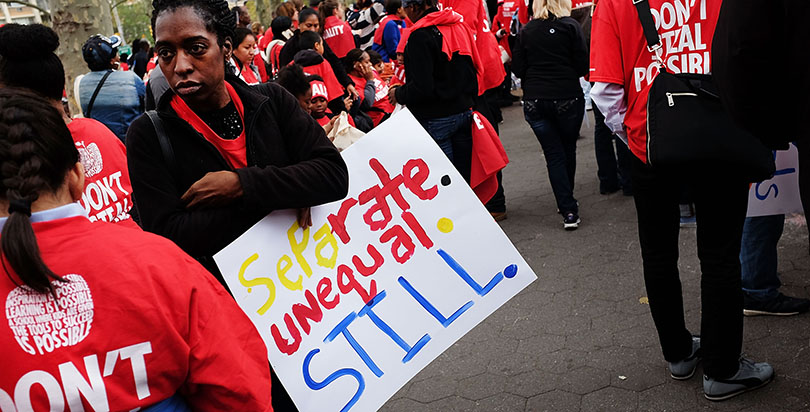Is School Segregation Getting Worse? By Some Measures, No — but It’s Not Getting Any Better

But is that true? Yes and no. Research shows that trends in segregation depend on how it’s measured and whether it’s based on race or socioeconomic status.
One might imagine that measuring segregation over time is straightforward, but that’s not the case. Ann Owens, a sociologist at the University of Southern California, said there are two main ways to assess the degree of segregation in schools. The first is based on “exposure,” meaning, in the case of racial segregation, the extent to which a student of color is likely to attend school with a white student, or vice versa.
The other option is to look at the “evenness” between the demographics of an individual public school and the population of public school students in the country as a whole. By this measure, if, say, 50 percent of all students are white, then a school that is half white would be considered perfectly integrated.
In some sense, these are different ways to get at the same question, but when used to examine trends in racial segregation, they come to divergent results. Owens said a review of research she conducted with Stanford University’s Sean Reardon showed that based on exposure measures, segregation has gotten worse in recent years; however, based on evenness metrics, racial segregation has stayed basically flat since 1980.
A study by Steven Rivkin of the University of Illinois at Chicago showed similar results. Another study using the evenness measure showed that school segregation actually fell in the 350 largest metropolitan areas between 1998 and 2010.
Why do the two measures arrive at different results?
The basic answer is that the population of public schools has changed significantly over time; there are significantly more students of color. The evenness measure accounts for changes in population when judging segregation, while the exposure measure doesn’t.
“It is true that over time the average African-American student or the average Hispanic student attends school with more minority students … but actually, the average white student is also attending school with more minority, particularly Hispanic students,” Owens said. “There’s just more minority students in the public school population … and there are fewer white students.”
What this means is that insofar as racial segregation is increasing, it’s because a larger share of the student population is non-white, not because of changes in the way students are sorted into schools. This is reflected in exposure indices but, by design, not in evenness measures.
The mixed results may be surprising, considering the weakening of a number of court-ordered integration plans in recent years. Owens’s research shows that these decrees made a big difference: “Court‐ordered desegregation was [one of the] most important factor[s] shaping the rapid declines in racial segregation in the 1960s and 1970s. Segregation declined sharply in school districts in the years immediately following court orders and implementation of desegregation plans.”
The lifting of a number of these orders probably helps explain why progress on racial integration has halted, but it’s notable that the trends, at least by evenness measures, haven’t reversed.
Owens and Reardon pointed out that black/white segregation in housing patterns is actually falling, which likely leads to improved school integration.
The picture, however, is much clearer — and more discouraging — when it comes to segregation based on family income. Owens said that her research with Reardon and Christopher Jencks shows that regardless of the measure used, class-based isolation in schools has gotten significantly worse since the early 1990s.
“For economic segregation, we see increases for both indices,” she said.
As Owens wrote in a blog post for the Brookings Institution, “By 2010, the average student eligible for free lunch attended school where about 60 percent of students were also eligible for free lunch, compared to 50 percent in 1991.”
Although a growing number of school districts have programs explicitly designed to keep schools integrated by socioeconomic status, they still cover only a tiny fraction of public school students. And these programs have not done nearly enough to overcome the rise of residential income segregation.
Another study by Owens shows that between 1990 and 2010, wealthier families with children have been more able to buy homes in neighborhoods zoned for certain schools. In other words, income inequality has manifested itself in schooling inequality and segregation, as families of means purchase the right to attend select schools. The research also found that income segregation between adults without kids was much smaller than between families with kids, suggesting that sorting into schools was a driving factor.
All in all, the research of Owens and others paints a complex picture of segregation trends. On the one hand, students of color are less likely to attend school with white students because the public school population as a whole is becoming less white. But racial segregation certainly hasn’t improved significantly in the past few decades.
Most troubling is the rise of income segregation. No matter how we slice the data, low-income students are increasingly likely to be isolated in schools, which research overwhelmingly finds has a deleterious effect on their academic progress.
Get stories like these delivered straight to your inbox. Sign up for The 74 Newsletter

;)
